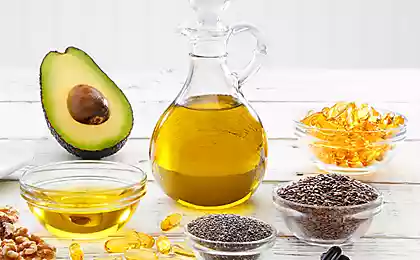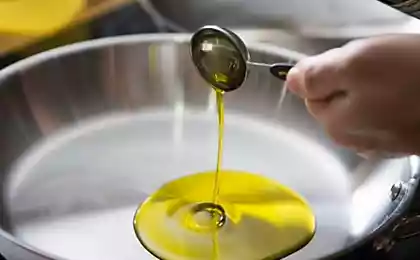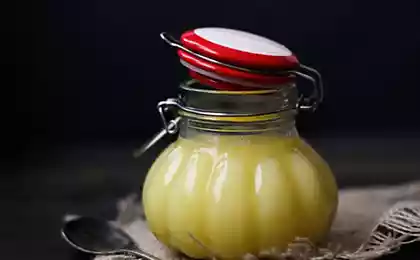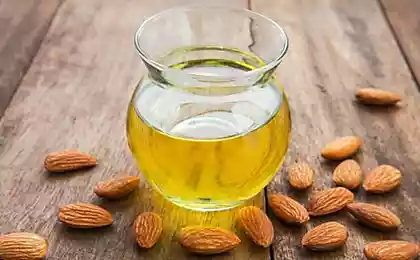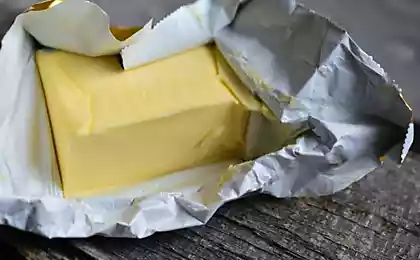534
Vegetable fat, margarine = myocardial infarction and cancer
The inscription "vegetable fat" is found in almost each packing with a product. And on the packaging of confectionery, bakery, dairy products such inscription is found in almost every case, condensed milk based on vegetable fat, cream and ice cream, cheese and curds, cakes and pastries...
The story of vegetable oils began in 1860, when the French Emperor Napoleon III offered a reward to anyone who will make a good substitute for butter, which is focused on the consumption of the armed forces and the lower classes of the population.
Currently, the wide spread and ubiquitous use of vegetable fats time due to their cheapness. Imagine what will be the cost of the product, the manufacturer put in it into a real cow butter?

Not only starch can be modified
Vegetable fat is an artificial product that the production is produced by modifying vegetable oils, namely gidrogenizatsii or transesterification.
Margarine is a whole family of modified vegetable oils used in the food industry. Margarines are a emulsion of modified oils in water.
In the process of modifying vegetable oil changes its physical properties from a liquid and becomes solid, resembling the consistency of cream.
Clearly let's see how it goes.
In the molecule of fat (triglyceride) are double bonds. The double bond can be present in the form of hands: two hands of a single atom holding the two hands of the second atom, or one hand different atoms. Look at figure A.
Now imagine that we are in production. Pour vegetable oil into the autoclave, set certain parameters of temperature and pressure and in the presence of a catalyst to skip the hydrogen. In the reaction the double bonds in the molecule of fat are broken and freed the "hands" of the atom attracts the hydrogen. Look at figure B.
This is a modified molecule of vegetable oil.

Figure A. Molecule of the triglyceride, unsaturated has double bonds. It is conventional oil.
Figure B. Molecule modifitsirovannogo triglyceride saturated, no double bonds, all occupied. This is already a vegetable fat.
O – the oxygen atoms, carbon atoms, R1, R2 and R3 are radicals of fatty acids, H – hydrogen atoms.
Because margarine is an emulsion of oil in water, it is obtained from vegetable fat then made emulsion, mixing along the way, emulsifiers, antioxidants and dyes.
TRANS fats
At first glance, everything is simple and natural: was the molecule without hydrogen, the hydrogen constituting the fatty acids remain in the molecule so the body get your dose of nutrients. However, all is not so clear. The catch lies in by-products, which necessarily are formed in the reaction.
As a result of the modification in vegetable oil produces by-products called TRANS-fats (TRANS-isomers of fatty acids). I won't bore you with long formulas, focus on the fact that scientists around the world find direct connection of these TRANS fats with the occurrence and development of cardiovascular (myocardial infarction, coronary artery disease), cancer, infertility and Alzheimer's disease.
TRANS fats are alien product and change for the worse biochemical processes in the body, influencing it at the cellular level.
Therefore, in European countries, there are maximum permissible levels of content of TRANS fat in vegetable fats and Margarines: up to 3-5%.
Of course, Industrialists all over the world are trying to reduce the percentage of TRANS fats and even get vegetable fats at all without them. It's on paper, but in reality, no one indicates on the packaging, what is in fact the proportion of TRANS isomers of fatty acids in a particular product.

Production of margarine in Russia is regulated by GOST 52178-2003 "Margarines. General technical conditions", but it States the marginal rate of TRANS-isomers ONLY for soft Margarines (MM), it is equal to 8%. Besides soft Margarines are more:
So for all other Margarines, but soft, the norms of TRANS-isomers fatty acids are not regulated. This means that margarine for baking can contain up to 40% TRANS fats!
Insights? Insights and let them do each for himself.published
Author: Anna Chubarikov
Also interesting: You should know: the impact of semi-products on our health
What You should know about refined sugar
Source: hrumburum.ru/post/39
The story of vegetable oils began in 1860, when the French Emperor Napoleon III offered a reward to anyone who will make a good substitute for butter, which is focused on the consumption of the armed forces and the lower classes of the population.
Currently, the wide spread and ubiquitous use of vegetable fats time due to their cheapness. Imagine what will be the cost of the product, the manufacturer put in it into a real cow butter?

Not only starch can be modified
Vegetable fat is an artificial product that the production is produced by modifying vegetable oils, namely gidrogenizatsii or transesterification.
Margarine is a whole family of modified vegetable oils used in the food industry. Margarines are a emulsion of modified oils in water.
In the process of modifying vegetable oil changes its physical properties from a liquid and becomes solid, resembling the consistency of cream.
Clearly let's see how it goes.
In the molecule of fat (triglyceride) are double bonds. The double bond can be present in the form of hands: two hands of a single atom holding the two hands of the second atom, or one hand different atoms. Look at figure A.
Now imagine that we are in production. Pour vegetable oil into the autoclave, set certain parameters of temperature and pressure and in the presence of a catalyst to skip the hydrogen. In the reaction the double bonds in the molecule of fat are broken and freed the "hands" of the atom attracts the hydrogen. Look at figure B.
This is a modified molecule of vegetable oil.

Figure A. Molecule of the triglyceride, unsaturated has double bonds. It is conventional oil.
Figure B. Molecule modifitsirovannogo triglyceride saturated, no double bonds, all occupied. This is already a vegetable fat.
O – the oxygen atoms, carbon atoms, R1, R2 and R3 are radicals of fatty acids, H – hydrogen atoms.
Because margarine is an emulsion of oil in water, it is obtained from vegetable fat then made emulsion, mixing along the way, emulsifiers, antioxidants and dyes.
TRANS fats
At first glance, everything is simple and natural: was the molecule without hydrogen, the hydrogen constituting the fatty acids remain in the molecule so the body get your dose of nutrients. However, all is not so clear. The catch lies in by-products, which necessarily are formed in the reaction.
As a result of the modification in vegetable oil produces by-products called TRANS-fats (TRANS-isomers of fatty acids). I won't bore you with long formulas, focus on the fact that scientists around the world find direct connection of these TRANS fats with the occurrence and development of cardiovascular (myocardial infarction, coronary artery disease), cancer, infertility and Alzheimer's disease.
TRANS fats are alien product and change for the worse biochemical processes in the body, influencing it at the cellular level.
Therefore, in European countries, there are maximum permissible levels of content of TRANS fat in vegetable fats and Margarines: up to 3-5%.
Of course, Industrialists all over the world are trying to reduce the percentage of TRANS fats and even get vegetable fats at all without them. It's on paper, but in reality, no one indicates on the packaging, what is in fact the proportion of TRANS isomers of fatty acids in a particular product.

Production of margarine in Russia is regulated by GOST 52178-2003 "Margarines. General technical conditions", but it States the marginal rate of TRANS-isomers ONLY for soft Margarines (MM), it is equal to 8%. Besides soft Margarines are more:
- MT — margarine solid for use in the food industry.
- MTS — margarine for lamination (for flaky baked goods).
- MTK — margarine for creams, soufflés and pastry.
- MM — soft margarine for human consumption (such as oil).
- SWC and IVS — liquid Margarines for the baking industry and deep-frying.
So for all other Margarines, but soft, the norms of TRANS-isomers fatty acids are not regulated. This means that margarine for baking can contain up to 40% TRANS fats!
Insights? Insights and let them do each for himself.published
Author: Anna Chubarikov
Also interesting: You should know: the impact of semi-products on our health
What You should know about refined sugar
Source: hrumburum.ru/post/39



